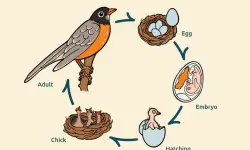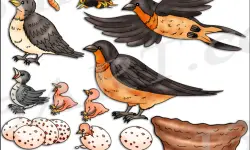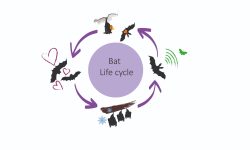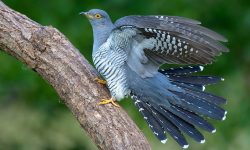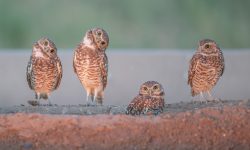The night owl, a mysterious symbol of nocturnal wisdom and stealth, lives a life shaped by darkness, silence, and precision. But behind its enigmatic stare lies a remarkable transformation—from a fragile egg to a skilled nighttime predator. This article explores the full life cycle of night owls, highlighting their reproductive strategies, developmental stages, and ecological roles.
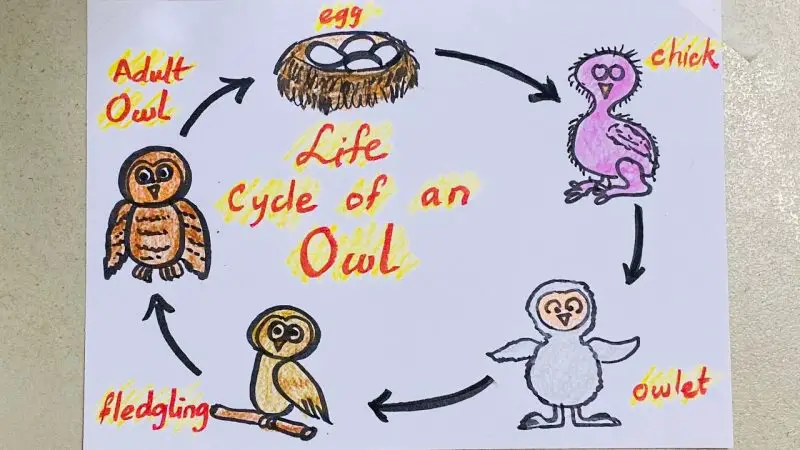
Reproduction and Egg Laying
Courtship Behavior and Pair Formation
In most nocturnal owl species, such as the Eastern Screech Owl (Megascops asio) and the Barn Owl (Tyto alba), reproduction is preceded by a seasonal courtship period in which males and females engage in complex social behaviors. These owls are generally seasonally monogamous, forming breeding pairs that persist for the duration of a nesting cycle, though some species may maintain longer pair bonds across years.
Courtship begins with territorial vocalizations by the male, designed to attract females and ward off rival males. Once a female is drawn to the male’s territory, the pair engages in mutual preening (allopreening), aerial displays, and courtship feeding, where the male presents prey items to the female. This behavior reinforces pair bonds and serves as a fitness indicator; a well-fed female is more likely to produce a viable clutch. These interactions also help the pair assess nesting suitability within the male’s territory.
Nest Site Selection and Characteristics
Unlike many diurnal bird species, night owls do not construct intricate nests from twigs or grasses. Instead, they are secondary cavity nesters, typically relying on natural hollows in trees, abandoned woodpecker holes, crevices in cliffs, barn lofts, or artificial nest boxes provided by humans. The structural integrity, insulation, and concealment of the site are crucial, as these features help regulate microclimate conditions and reduce exposure to predators and environmental stressors.
The proximity of the nest to hunting grounds rich in small mammals and insects is essential, especially during incubation and chick-rearing phases when energy demands are highest. Some species demonstrate site fidelity, returning to the same nesting area in successive years if environmental conditions remain favorable.
Oviposition and Incubation Dynamics
Once a suitable nesting site has been secured, the female begins laying eggs, with clutch sizes typically ranging from 2 to 8, depending on the species, environmental conditions, and food availability. Eggs are laid asynchronously—one egg every 1 to 3 days—resulting in hatchlings of different ages and sizes within a single brood. This staggered hatching is thought to be an evolutionary strategy that maximizes offspring survival during periods of fluctuating prey abundance.
Each egg is white, oval-shaped, and has a slightly rough, calcareous shell. The female is solely responsible for incubation, which lasts approximately 26 to 35 days, depending on species and ambient temperature. During this time, she maintains optimal egg temperature through brood patch contact and adjusts her position regularly to ensure even heat distribution.
While the female remains at the nest, the male assumes the role of provisioning partner, foraging nocturnally to supply the incubating female with prey. His efficiency as a hunter is critical; inadequate food delivery may lead to decreased incubation attentiveness or egg abandonment.
Hatching and Early Life
Altricial Development and Sibling Hierarchies
Hatching in night owls occurs asynchronously due to staggered oviposition, meaning chicks emerge over several days in the order the eggs were laid. As a result, a size and developmental hierarchy is established within the brood. Night owl chicks are highly altricial at birth—they emerge from the egg blind, featherless, and entirely dependent on parental care for warmth, nourishment, and protection.
This disparity in hatching time can lead to intra-brood competition, where larger, more developed nestlings outcompete their smaller siblings for food. In times of prey scarcity, this may result in facultative siblicide, a survival strategy whereby older chicks may outcompete, injure, or even kill their younger siblings. While harsh, this behavior can ensure that at least some offspring survive in unpredictable environments.
Parental Provisioning and Nestling Growth
Following hatching, both parents—though primarily the male—engage in prey acquisition, delivering small vertebrates and invertebrates such as mice, voles, shrews, insects, and occasionally small birds. Prey is either regurgitated, offered whole, or torn into manageable pieces by the female before being fed to the nestlings.
The nestling period typically spans 28 to 35 days, during which the chicks undergo rapid somatic growth. Initially covered in white natal down, they soon begin to grow mesoptile (secondary) down and subsequently juvenile flight feathers (remiges and rectrices). These feather developments are essential for insulation and future flight capabilities.
Thermoregulatory capacity also improves significantly during this phase. While newly hatched chicks are ectothermic, relying on the brooding female for warmth, they gradually develop endothermy, allowing them to regulate their own body temperature by the end of the nestling period. Coordination improves in parallel with neuromuscular maturation, enabling chicks to stand, preen, and eventually flap their wings in preparation for fledging.
Fledging and Juvenile Development
Branching and First Flight Attempts
As juvenile night owls complete feather development—particularly the growth of their remiges (primary and secondary flight feathers) and rectrices (tail feathers)—they begin engaging in pre-flight behaviors. One of the most critical is branching, where fledglings leave the nest cavity or platform to climb nearby branches using their beak and talons for balance. This activity builds muscle coordination and spatial awareness essential for controlled flight.
Fledging, the moment of first sustained flight, typically occurs between 5 to 7 weeks of age. Although they achieve lift-off, fledglings are not yet fully proficient in navigating the complex forest or open terrain. During this phase, they remain close to the nesting site and often emit food-begging calls that help parents locate and provision them.
Post-Fledging Care and Hunting Apprenticeship
After fledging, juvenile owls enter a dependent post-fledging period, which can last several weeks. Although they possess the physical ability to fly, ecological competence—the suite of skills needed to hunt, navigate, and avoid predators—develops more gradually.
Parents, especially the male, continue to deliver prey items, while juveniles begin mimicking adult behaviors such as perch hunting, silent gliding, and prey pouncing. This apprenticeship phase is essential for learning how to capture live prey with precision. The use of their acute binaural hearing and asymmetrical ear placement for sound triangulation also sharpens during this time, allowing them to detect and strike at prey in total darkness.
Dispersal and Survival Challenges
By 8 to 12 weeks of age, most young night owls achieve full independence. They begin dispersing from their natal territory, often traveling several kilometers to establish their own home ranges. This dispersal reduces competition with siblings and parents and promotes genetic diversity across the population.
However, juvenile mortality rates remain high during the first year. Factors such as inexperienced hunting, predation by larger raptors, vehicle collisions, and habitat fragmentation can all impact survival. Nonetheless, those that adapt successfully to their environment enter the subadult phase and may reach sexual maturity by the following breeding season, thereby contributing to the species’ reproductive cycle.
Adulthood and Predatory Mastery
Reaching Maturity and Lifespan
Night owls, like most raptorial birds, reach sexual maturity within their first to second year, with the exact timing influenced by species-specific growth rates, prey abundance, and habitat stability. For instance, Barn Owls (Tyto alba) often breed in their first year, while larger species such as the Great Horned Owl (Bubo virginianus) may not reproduce until their second or third year.
In the wild, owls exhibit variable life expectancy—typically between 5 and 15 years. However, individuals raised or rehabilitated in captivity, where threats such as disease, predation, and starvation are minimized, have been documented living over two decades. Factors affecting wild longevity include territorial conflicts, exposure to rodenticides, habitat degradation, and climate fluctuations.
Advanced Hunting Strategies
As adults, night owls become apex nocturnal predators within their ecosystems. Their success stems from a highly specialized suite of adaptations:
-
Facial discs funnel sound toward asymmetrical ear openings, enabling precise prey localization even under snow or leaf litter.
-
Large, tubular eyes with high rod density provide superior night vision, though they cannot rotate—hence their ability to rotate the neck up to 270 degrees.
-
Their flight feathers are uniquely structured to minimize turbulence, allowing for nearly silent flight that prevents detection by prey.
Adults employ a perch-and-pounce hunting technique, scanning the environment from a vantage point before launching a swift, silent ambush. The diet remains broad and opportunistic, comprising mice, voles, shrews, frogs, lizards, moths, and small birds. Larger owls like the Great Horned Owl have been observed capturing prey as large as rabbits or even skunks, using their powerful zygodactyl talons and sharp beaks to dispatch victims efficiently.
Territoriality and Seasonal Fidelity
Territoriality becomes especially pronounced during the breeding season, when both sexes work to defend nesting sites. Vocalizations, including hoots, screeches, and trills, are used to signal presence and deter rivals. In some species, males perform aerial displays or food offerings to strengthen pair bonds and assert dominance.
Territorial range sizes vary based on prey density and species. Sedentary species may remain in the same core territory year-round, while nomadic or partially migratory owls, such as the Short-eared Owl (Asio flammeus), shift territories in response to rodent population cycles or seasonal habitat changes.
Seasonal Challenges and Adaptations
Surviving Harsh Winters
For night owls inhabiting temperate and boreal regions, winter presents a series of physiological and ecological challenges. As temperatures drop and snow blankets the landscape, prey becomes harder to locate and capture. To cope, owls rely on a combination of morphological, behavioral, and metabolic adaptations.
Their dense, layered plumage traps heat and reduces convective heat loss, effectively insulating the body during sub-zero conditions. Feathers also extend down the legs and feet, a feature known as feathered tarsi, providing further thermal protection. To conserve energy, owls may reduce their hunting frequency and limit long flights during extreme cold, opting to perch for longer intervals and strike only when prey is detected.
Additionally, many species exhibit dietary flexibility, shifting to alternate prey when rodents become scarce. Some will opportunistically take birds roosting at night, or consume amphibians that remain active in milder winter periods. This ability to adjust prey preferences enhances winter survival.
Migration and Movement Patterns
Although owls are generally non-migratory, seasonal movements do occur in certain species and populations. For example, the Short-eared Owl (Asio flammeus) and Northern Saw-whet Owl (Aegolius acadicus) engage in irruptive or partial migrations, driven more by prey availability than by temperature alone.
These movements are typically short- to medium-range, involving shifts to lower elevations or more temperate zones rather than true long-distance migration. Young owls, especially newly independent juveniles, are more likely to disperse widely from their natal sites. This post-fledging dispersal helps reduce intraspecific competition for territory and food.
Advances in GPS telemetry and banding programs have revealed that some owls may travel hundreds of kilometers during winter, crossing forests, open fields, and even urban environments in search of optimal foraging grounds. These nomadic tendencies underscore the importance of preserving diverse habitats across seasons to support owl populations throughout their life cycles.
The Owl’s Role in the Ecosystem
Natural Pest Controllers
Night owls are essential ecological agents in trophic regulation, especially in terrestrial ecosystems. As apex or mesopredators, they play a major role in controlling populations of small mammals and insects, thus maintaining ecological balance. Species like the Barn Owl (Tyto alba) are especially effective in agricultural areas. A single breeding pair and their offspring can consume over 3,000 rodents in one season, targeting pests such as voles, mice, and rats that can devastate crops and stored grain.
By naturally suppressing pest populations, owls reduce the need for chemical rodenticides, which often have secondary toxic effects on non-target species. Their hunting efficiency contributes to sustainable farming practices, especially in organic systems that rely on biological pest control. Even in urban and suburban areas, owls reduce rodent populations in parks, gardens, and waste zones, improving public health by curbing disease vectors such as hantavirus and leptospirosis.
Indicators of Environmental Health
Owls are not just predators; they are also sentinels of ecosystem integrity. As upper-level consumers, their health reflects the condition of the habitats and food webs below them. Population declines, deformities, or reproductive failures in owl communities are early warning signs of environmental stress, such as:
-
Habitat fragmentation
-
Bioaccumulation of toxins (e.g., heavy metals, pesticides)
-
Declines in prey availability
-
Light and noise pollution
Researchers frequently use owls in ecotoxicological studies because their tissues, feathers, and pellets reveal information about chemical exposure and biodiversity trends in the environments they occupy.
Protecting owl populations indirectly promotes biodiversity conservation, as it ensures that large, healthy ecosystems remain intact. From temperate forests to arid grasslands, owls are vital to the structure, function, and resilience of the ecosystems they inhabit.
Conservation and Future Threats
Habitat Loss and Human Conflict
One of the most significant challenges facing night owls today is habitat loss, particularly due to deforestation, agricultural expansion, and urban sprawl. Many owl species depend on mature forests with ample cavities or snags for nesting and roosting. As these habitats are cleared for logging or development, owls are forced into suboptimal environments, leading to reduced reproductive success and increased mortality.
Agricultural intensification and pesticide use further disrupt owl populations by diminishing prey abundance and introducing toxins into the food chain. Insectivorous and rodent-eating owls, such as the Barn Owl or Eastern Screech Owl, are particularly vulnerable to secondary poisoning from rodenticides and bioaccumulated chemicals. Human-wildlife conflict also arises when owls nest in barns or buildings and are perceived as pests, leading to deliberate persecution in some regions.
Light Pollution and Collisions
As nocturnal predators, owls are highly sensitive to artificial light. Urban light pollution interferes with their hunting efficiency, prey detection, and orientation. It can disrupt circadian rhythms and suppress critical behaviors such as courtship or nocturnal communication through calls.
Furthermore, owls often fall victim to vehicle strikes, especially when flying low across roads in pursuit of prey. Glass windows, power lines, and wind turbines present additional collision risks. Fast-flying species with poor maneuverability or strong attraction to road edges and open fields are especially vulnerable.
Protection Measures
Effective owl conservation requires a multifaceted approach grounded in habitat protection, research, and public awareness. Key measures include:
-
Habitat restoration and preservation, particularly of old-growth forests, wetlands, and grasslands essential for breeding and foraging.
-
Installation of artificial nest boxes in both rural and urban areas, helping cavity-nesting species that suffer from the loss of natural nesting sites.
-
Reduction in rodenticide and pesticide use, promoting non-lethal and ecological alternatives for pest control.
-
Implementation of wildlife corridors and road mitigation measures, such as underpasses and owl reflectors, to reduce collision risk.
-
Environmental education and outreach, aimed at dispelling superstitions and promoting positive attitudes toward owls as beneficial predators.
-
Wildlife rehabilitation centers, which rescue and treat injured or orphaned owls before releasing them back into the wild. These facilities also serve as important hubs for public engagement and species monitoring.
Long-term conservation success will depend on integrated policy frameworks that consider land use, climate resilience, and the preservation of nocturnal ecosystems. Protecting night owls not only ensures their survival but also secures the health and balance of the ecosystems they quietly govern from the shadows.
Conclusion: A Life Cloaked in Darkness
The life cycle of a night owl is an extraordinary journey that begins quietly in a dark, hidden nest and culminates in the silent flight of a skilled predator. These birds of the night are more than symbols of mystery—they are vital to the balance of ecosystems. Understanding and protecting their life cycle is key to ensuring that the haunting call of the owl continues to echo through our forests for generations to come.

